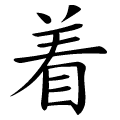着
- to attach, to put on, to arrive, to touch, to be affected by;
Also used as a grammatical particle indicating completion or ongoing state.
Etymology
Originally identical to 著 (저, “to appear; to manifest”).
The ancient form combined 竹 (대 죽, “bamboo”) and 者 (사람 자) — representing writing or marking on bamboo slips.
Over time, the upper 竹 radical evolved into 艹 (풀 초), and later, through a series of clerical script (隸書 lìshū) simplifications, 艹 + 土 transformed into 羊 (양).
The lower portion, initially resembling 日, was modified into 目 (눈 목) to produce the modern form 着.
Thus, 着 and 著 are etymologically the same character, diverging only in script evolution and later conventional usage.
Usage in Korean
착지 (着地) — to land, touch the ground
착용 (着用) — to wear, put on
착화 (着火) — to ignite, catch fire
착수 (着手) — to begin, start work on something
착상 (着想) — to conceive an idea, inspiration
착륙 (着陸) — to land (aircraft)
안착 (安着) — to arrive safely
In modern Korean, 着 implies completion of an action leading to a state — e.g. “arrived,” “attached,” or “worn.”
Words that derived from 着
Additional notes
Despite its simple appearance, 着 is one of the most semantically versatile and phonetically complex characters in East Asian languages, bridging physical contact, emotional connection, and grammatical aspect.
Relationship with 著 (저):
Originally one and the same character, used interchangeably for “to manifest, to attach, to wear.”
Modern differentiation:
着 — “to attach, wear, arrive”; grammatical and physical sense.
著 — “to appear, to author, to become evident”; intellectual and visible sense.
In Taiwan and classical writing, 著 alone covers both meanings;
in Korea, Japan, and mainland China, the two forms have been officially separated.
Cultural & symbolic notes:
In literary and philosophical contexts, 着 transcends its physical meaning of “contact” to express immersion and realization — the state of becoming one with an act.
In Zen (禪) and Daoist language, “着相” (착상, “attachment to form”) refers to clinging to appearances, a concept of mental fixation that must be overcome to attain enlightenment.
In poetry and calligraphy, 着 often symbolizes the moment of arrival or manifestation — when a brush finally touches paper or when an emotion finds expression.
「筆未着紙而意已成」
“Before the brush touches the paper, the idea is already complete.”
Thus, 着 embodies both physical contact and spiritual realization — a point of union between intention and action.
Alternative forms
In mainland China, the top component is written ⺶ (the 丿 stroke is not split into two strokes).
In Hong Kong, Japan and Korea, the top component is written 𦍌 followed by 丿 (split into two separate components).
A CJK compatibility ideograph exists at U+FAAA for the alternative form used in Taiwan that resembles the form used in Hong Kong/Japan/Korea that is written with 12 strokes.
- 廿手月山 (TQBU)
- ⿸ ⺶ 目 (G T)
- U+FAAA)
- ⿱ 𦍌 ⿰ 丿 目 (H J K)
